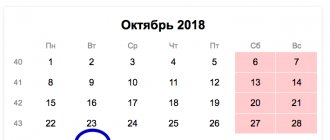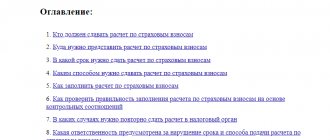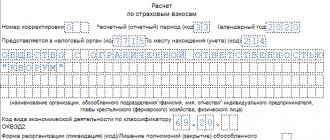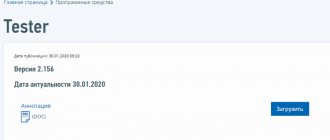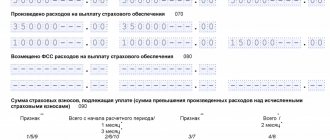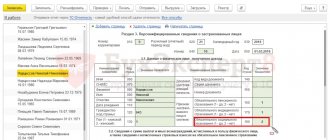What is section 3 for and who fills it out?
In 2021, a new form of calculation for insurance premiums will be used. The form was approved by order of the Federal Tax Service of Russia dated October 10, 2021 No. ММВ-7-11/551. See “Form for calculating insurance premiums from 2021”.
This reporting form includes section 3 “Personalized information about insured persons.” In 2021, section 3 as part of the calculation of contributions must be filled out by all organizations and individual entrepreneurs that have paid income (payments and rewards) to individuals since January 1, 2017. That is, section 3 is a mandatory section.
Unified calculation of insurance premiums to the Federal Tax Service
Home / Reporting for employees
Zero settlement on insurance premiums
View a sample zero calculation for insurance premiums
All business entities with at least one employee are required to submit calculations of contributions.
If during the reporting period the entity did not conduct business and did not pay remuneration to individuals, it is necessary to submit a zero calculation.
Form zero should also be submitted to organizations that have only a general director, who is the sole founder.
Individual entrepreneurs who do not have employees do not submit insurance premium payments.
The zero ERSV should include the following form sheets:
- title;
- section 1;
- subsections 1.1. and 1.2 of Appendix 1 to Section 1;
- appendix 2 to section 1;
- section 3 (except for subsection 3.2.).
Penalties for failure to submit forms and calculations with errors
The minimum fine for late submission of the form will be RUB 1,000. for each full or partial month of delay, starting from the last date provided for the payment. But such a fine is possible only if the insurance premiums were transferred to the treasury on time (clause 1 of Article 119 of the Tax Code of the Russian Federation).
If the contributions reflected in the calculation are not received by the budget on time, the sanctions will amount to 5% of the unpaid amount for each month of delay. In this case, the fine should not exceed 30% of this amount, but cannot be less than 1000 rubles.
If part of the insurance premiums was paid on time, then sanctions will be assessed only on the amount of premiums paid after the due date.
Failure to submit a report is not grounds for blocking the policyholder’s bank accounts (letter of the Ministry of Finance of the Russian Federation dated January 12, 2017 No. 03-02-07/1/556).
ERSV will be considered not represented if:
1) For each individual employee the following are incorrectly indicated:
- personal information (full name; INN - if available; SNILS);
- amounts of remuneration and other payments;
- base for calculating contributions to compulsory pension insurance within the limit;
- the amount of contributions to compulsory pension insurance, calculated within the limit;
- base for calculating contributions to compulsory pension insurance for additional tariff;
- the amount of contributions to compulsory pension insurance according to additional tariff.
2) In general, for the organization (IP), the report contains the following errors:
- the amount of accrued contributions (within the limit) is incorrectly indicated both for the entire reporting (calculation) period and for any month (for all the last 3 months) of the period;
- data on the total amount of contributions to compulsory pension insurance do not correspond to the amount of contributions for each individual employee.
In this case, the Federal Tax Service will send a notification to the policyholder, upon receipt of which it is necessary to eliminate the identified inconsistencies.
The corrected calculation should be submitted to the inspectorate:
- within 5 working days from the date of receipt of the electronic notification;
- within 10 working days if the letter from the Federal Tax Service arrived by mail.
Then the date of submission of the ERSV will be considered the date when the calculation was submitted for the first time.
If the policyholder discovers that the submitted calculation contains incorrect information, you must proceed as follows:
| An error led to an underestimation of the amount of payments to the budget | An updated ERSV is submitted, including the corrected sheets, correctly filled out other sheets submitted earlier, and section 3 - only for those persons whose information has been changed. That is, there is no need to submit Section 3 again in full |
| The error did not affect the calculation results | Submission of the adjustment calculation is carried out at the request of the business entity |
Control ratios for calculation of insurance premiums
Verification of the correct completion of reporting indicators is carried out on the basis of a special regulation published by the Federal Tax Service. The control ratios for the calculation of contributions are indicated in the letter of the Federal Tax Service of the Russian Federation dated June 30, 2017 No. BS-4-11/12678. From 01/01/2018, additional control ratios listed in the appendix to the letter of the Federal Tax Service dated 12/29/2017 No. GD-4-11/ [email protected]
The most significant indicators are subject to verification first:
- information about the employees of the business entity - the information presented in the report is verified with the data of the Federal Tax Service;
- final amounts of payments – the amounts of budget revenues are compared with reporting data;
- deadlines for submitting the calculation - the compliance of the date of actual submission of the calculation with the deadline established by the Tax Code of the Russian Federation is checked.
Also, the calculation data is subject to reconciliation with other reporting documentation. According to current rules, information from the ERSV is verified with data from form 6-NDFL.
The main criterion is the comparison of line 030 of subsection 1.1. Annex 1 ERSV (amount of accrued payments to individuals) with line 020 of section 1 in 6-NDFL (total amount of income for all citizens).
In addition, controllers monitor the ratio of current payments and documentation of previous periods - the correctness of the accrual of insurance premiums on an accrual basis is checked.
In total, letters from the Federal Tax Service contain more than 300 control ratios. It is extremely difficult to check all the indicators yourself.
Programs for checking the calculation of insurance premiums
Some specialized accounting websites have launched services to check the correctness of the calculation of contributions and its reconciliation with form 6-NDFL. For example, on the Aktion-MCFER family of sites (some sites require prior registration):
- https://rsv.rnk.ru;
- https://rsv.zarplata-online.ru;
- https://ersv.glavbukh.ru.
You can check the accuracy of the personal data of employees from section 3 of the ERSV directly in your personal account on the Federal Tax Service website. The service “Request for verification of TIN, full name, SNILS of working persons” is presented for taxpayers.
Read in more detail: Example of filling out a single calculation for insurance premiums
Did you like the article? Share on social media networks:
- Related Posts
- Sample of filling out the zero 4-FSS for the 1st quarter of 2021
- Sample of filling out the KND form 1110018
- 6-NDFL for the 1st quarter of 2021
- Help on form 2-NDFL in 2021
- Sample of filling out certificate 2-NDFL
- Form SZV-STAZH - new reporting 2021
- Sample of filling out the SZV-M form
- Sample of filling out the SZV-STAZH form
Discussion: 2 comments
- Hope:
09.28.2018 at 13:34SUPER!!!!!!!!!!
Answer
- Marina:
01/16/2019 at 14:10
Thanks for the prepared material! I prepared reports with your service.
Answer
Leave a comment Cancel reply
Who to include in section 3
Section 3 provides for the inclusion of personalized information for each individual in relation to whom in the last three months of the reporting (calculation) period the organization or individual entrepreneur was the insured. It does not matter whether during this period there were payments and rewards in favor of such individuals. That is, if, for example, in January, February and March 2021, an employee under an employment contract was on leave without pay, then this should also be included in section 3 of the calculation for the 1st quarter of 2021. Since during the designated period of time he was in an employment relationship with the organization and was recognized as an insured person.
Of course, it is necessary to formulate section 3 for persons in whose favor in the last three months of the reporting period there were payments and remunerations under employment or civil law contracts (clause 22.1 of the Procedure for filling out calculations for insurance premiums, approved by order of the Federal Tax Service of Russia dated October 10, 2021 No. MMV -7-11/551).
Let us assume that during the reporting period a civil contract (for example, a contract) was concluded with an individual, but the person did not receive any payments under this contract, since the services (work) have not yet been provided (performed). In this case, is it necessary to include it in section 3 of the calculation of insurance premiums? In our opinion, yes, it is necessary. The fact is that those employed under civil contracts are also recognized as insured persons by virtue of paragraph 2 of clause 1 of Article 7 of the Federal Law of December 15, 2001 No. 167-FZ “On Compulsory Pension Insurance”.
We also believe that section 3 should be formed for the general director, the only founder with whom the employment contract has been concluded. After all, such persons are also named in paragraph 2 of paragraph 1 of Article 7 of the Federal Law of December 15, 2001 No. 167-FZ “On Compulsory Pension Insurance”. Therefore, they should fall under section 3. Even if they did not receive any payments from their own organization in the last three months of the reporting period.
How to fill out RSV automatically
If you keep personnel records and calculate salaries in an accounting program or web service, the report will be generated automatically. Kontur.Accounting is an example of a cloud service for accounting, payroll and reporting. Here you can send the RSV to the tax office directly from the service. The calculation is checked automatically before sending.
An example of filling out the DAM for an organization with two employees
Filling out the cover page of the calculation for the second and third quarters is practically the same. The only difference is the reporting period code. In the first quarter it is code “21”, in the second quarter it is “31”, and in the third quarter it is “33”. Other codes are provided for reorganization and liquidation.
How to fill out section 3: detailed analysis
Initial part
If you are filling out personalized information for a person for the first time, then enter “0–” on line 010. If you are submitting an updated calculation for the corresponding billing (reporting) period, then show the adjustment number (for example, “1–,” “2–,” etc.). In field 020, reflect the code of the billing (reporting) period, for example:
- code 21 – for the first quarter;
- code 31 – for half a year;
- code 33 – for nine months;
- code 34 – per year.
In field 030, indicate the year for the billing (reporting) period of which personalized information is provided.
Check
The value of field 020 of section 3 must correspond to the indicator of the field “Calculation (reporting period (code)”) of the title page of the calculation, and field 030 of section 3 - the value of the field “Calendar year” of the title page.
In field 040, reflect the serial number of the information. And in field 050 – the date of submission of information. As a result, the initial part of section 3 should look like this:
Subsection 3.1
In subsection 3.1 of the calculation, indicate the personal data of the individual for whom section 3 is being filled out. We will explain what personal data to indicate and provide a sample:
| Line | Filling |
| 060 | TIN (if available) |
| 070 | SNILS |
| 080, 090 and 100 | FULL NAME. |
| 110 | Date of Birth |
| 120 | Code of the country of which the individual is a citizen from the Classifier approved on December 14, 2001 No. 529-st, OK (MK (ISO 3166) 004-97) 025-2001 |
| 130 | digital gender code: “1” – male, “2” – female |
| 140 | Identity document type code |
| 150 | Details of the identity document (series and document number) |
| 160, 170 and 180 | Sign of an insured person in the system of compulsory pension, medical and social insurance: “1” – is an insured person, “2” – is not an insured person |
Subsection 3.2
Subsection 3.2 contains information about the amounts:
- payments to employees;
- accrued insurance contributions for compulsory pension insurance.
However, if you are filling out section 3 for a person who has not received any payments in the last 3 months of the reporting (settlement) period, then this subsection does not need to be filled out. This is stated in paragraph 22.2 of the Procedure for filling out calculations for insurance premiums, approved by order of the Federal Tax Service of Russia dated October 10, 2021 No. ММВ-7-11/551. If the fact of payments took place, then fill out the following fields:
| Count | Filling |
| 190 | The serial number of the month in the calendar year (“01”, “02”, “03”, “04”, “05”, etc.) for the first, second and third month of the last three months of the billing (reporting) period, respectively. |
| 200 | Category code of the insured person (according to Appendix 8 to the Procedure for filling out the calculation). Enter the code in capital letters of the Russian alphabet. For example - HP. |
| 210 | The total amount of payments in favor of an individual for the first, second and third months of the last three months of the billing (reporting) period, respectively. |
| 220 | The basis for calculating pension contributions, not exceeding the maximum value. In 2021, this value is 876,000 rubles. |
| 230 | The amount of payments under civil contracts (allocated from the database). |
| 240 | Amount of pension insurance contributions. |
| 250 | The total amount of payments in favor of the employee, not exceeding the maximum base amount for all three months of the reporting (billing) period. |
Let's give an example.
Example
Lobzik and Company LLC is preparing calculations for insurance premiums for the 1st quarter of 2021. In section 3, the accountant needs to include data on mechanic O.V. Romashkin. In January, February and March 2021, he received 30,000 rubles monthly. The accountant included the entire amount in the base for calculating insurance premiums. The accountant filled out subsection 3.2 as follows:
If you apply different insurance premium rates, fill out the required number of lines.
Subsection 3.2.2
In subsection 3.2.2, reflect the payments from which pension contributions were calculated at additional tariffs. The transcript of this section is as follows:
| Count | Filling |
| 260 | The serial number of the month in the calendar year (“01”, “02”, “03”, “04”, “05”, etc.) for the first, second and third month of the last three months of the billing (reporting) period, respectively. |
| 270 | Tariff code. |
| 280 | Amounts of payments from which contributions at additional tariffs were calculated. |
| 290 | Amount of insurance premiums at additional rates. |
| 300 | The total amount of payments and insurance premiums. |
Read also
31.03.2017
Appendix 1 and 2 of section 1 with code “20”
No need for a second time
fill out Appendix 1 and 2 of section 1 with code “20” if your company does not have employees whose wages exceed the minimum wage - 12,130 rubles.
Section 1 of the DAM for the first half of 2021 with code “20” - payments taxed at a reduced rate of 15%.
Line 030
subsections 1.1 and 1.2 of Appendix No. 1 and
line 020
of Appendix No. 2.
Here they indicate the amount of payments for April - June (including for the first, second and third months of the last three months) in an amount exceeding 12,130 rubles. per employee.
Line 050
subsections 1.1 and 1.2 of Appendix No. 1 and Appendix No. 2 to the calculation.
Here they indicate the base for insurance premiums for April - June (including for the first, second and third months of the last three months) in an amount exceeding 12,130 rubles. per month.
Line 060
Subsection 1.1 of Appendix No. 1.
This line reflects the amount of contributions to compulsory health insurance at a rate of 10% from the base for insurance premiums, which is indicated in line 050
Subsection 1.1 of Appendix No. 1 to Section 1 of the calculation.
Line 060
Subsection 1.2 of Appendix No. 1.
Here you need to indicate the amount of contributions for compulsory medical insurance at a rate of 5% from the base for insurance premiums, which is indicated in line 050
Subsection 1.1 of Appendix No. 1 to Section 1 of the calculation.
Line 060
Appendix No. 2 to the calculation.
You need to put dashes in this line. Since compulsory social insurance contributions are not charged for amounts over 12,130 rubles, the tariff is 0%.
More on the topic:
Reduced and preferential tariffs for SMEs: how to reflect them in the DAM?
Features of filling out the DAM for the 1st half of 2021
